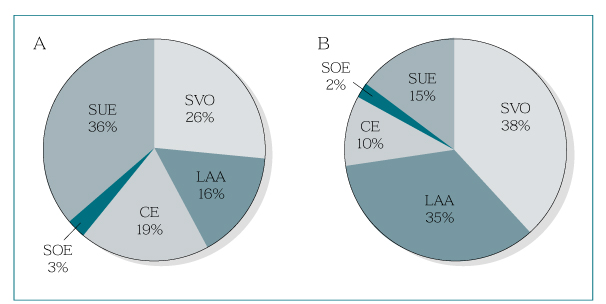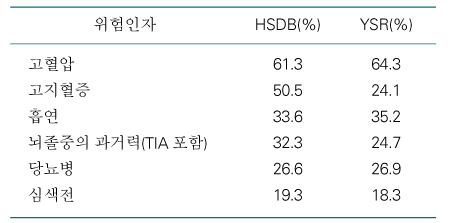 |
 |
- Search
| J Korean Med Assoc > Volume 47(7); 2004 > Article |
Abstract
Stroke is one of the leading causes of deaths in Korea. According to the report from Korean National Statistical Office, the mortality rate of stroke was 77.2/100,000 persons in 2002. In the past, hemorrhagic stroke was more prevalent than ischemic stroke in Korea. However, the ratio of hemorrhagic to ischemic stroke has been reversed since late-1980s. This trend might be due to the westernization of lifestyle as well as better control of stroke risk factors such as hypertension and diabetes. Of ischemic stroke, the incidence of cardioembolism is relatively low in Korea compared with in Western countries, especially in posterior circulation disorders. This observation reflects the epidemiologic characteristic of stroke in Korea where the prevalence of cardiac diseases is relatively low. The case fatality rate from one of the largest hospital-based stroke registries was 7.7% within 30 days after the onset of acute ischemic stroke, which is similar to those from other series in western countries with advanced medical care systems. However, the delay of hospital visit after the onset of stroke and the lower compliance for secondary prevention remain obstacles in managing stroke patients in Korea.
References
2. Klag MJ, Whelton PK, Seider AJ. Decline in US stroke mortality : Demographic trends and antihypertensive treatment. Stroke 1989;20:14-21.
3. Cooper R, Sempos C, Hsieh S-C, Kovar MG. Slowdown in the decline of stroke mortality in the United States, 1978-1986. Stroke 1990;21:1274-1279.
4. Gillum RF. Cerebrovascular disease morbidity in the United States, 1970-1983:Age, sex, region, and vascular surgery. Stroke 1986;17:656-651.
5. Wolf PA, D'agostino RB. Epidemiology of stroke. Stroke. Pathophysiology, diagnosis, and management 1998;3rd ed. New York: Churchill Livingstone. 3-28.
12. Lee BI, Nam HS, Heo JH, Kim DI. The Yonsei Stroke Team. Yonsei Stroke Registry. Cerebrovasc dis 2001;12:145-151.
15. McGovern PG, Burke GL, Sprafka JM. Trends in morbidity, mortality and risk factor levels for stroke from 1960 through 1990 : The Minnesota Heart Survey. JAMA 1992;268:753-759.
16. Collins R, MacMahon S. Blood pressure, antihypertensive treatment and the risks of stroke and of coronary heart disease. Br Med Bull 1994;50:272-298.
18. Bounds JV, Wiebers DO, Whisnant JP, Okazaki H. Mechanisms and timing of deaths from cerebral infarction. Stroke 1981;12:474-477.
19. Ahmed OI, Orchard JT, Sharma R, Mitchell H, Talbo E. Declining mortality from stroke in Allegheny Country, Pennsylvania : Trends in case fatality and severity of disease, 1971-1980. Stroke 1988;19:181-184.
20. Ueda K, Hasuo Y, Kiyohara Y. Intracerebral hemorrhage in a Japanese community, Hisayama : Incidence, changing pattern during longterm follow-up, and related factors. Stroke 1988;19:48-52.
21. The National Institute of Neurological Disorders and Stroke rtPA Stroke Study Group. Tissue plasminogen activator for acute ischemic stroke. N Engl J Med 1995;333:1581-1587.
25. Kim JS, Yoon SS. Perspectives of Stroke in Persons Living in Seoul, South Korea, A survey of 1,000 Subjects. Stroke 1997;28:1165-1169.
- TOOLS
-
METRICS

-
- 2 Crossref
- Scopus
- 1,222 View
- 5 Download
-
Related articles in
J Korean Med Assoc -
Epidemiology and pathogenesis of scabies2023 December;66(12)
Epidemiology and diagnosis of inflammatory bowel diseases2021 September;64(9)
Diagnosis of Colorectal Cancer Overview and Clinical Features of Colorectal Cancer2002 July;45(7)
Diagnosis of Cerebrovascular Disease2002 December;45(12)
Epidemiology and Risk Factors of Breast Cancer2003 June;46(6)








